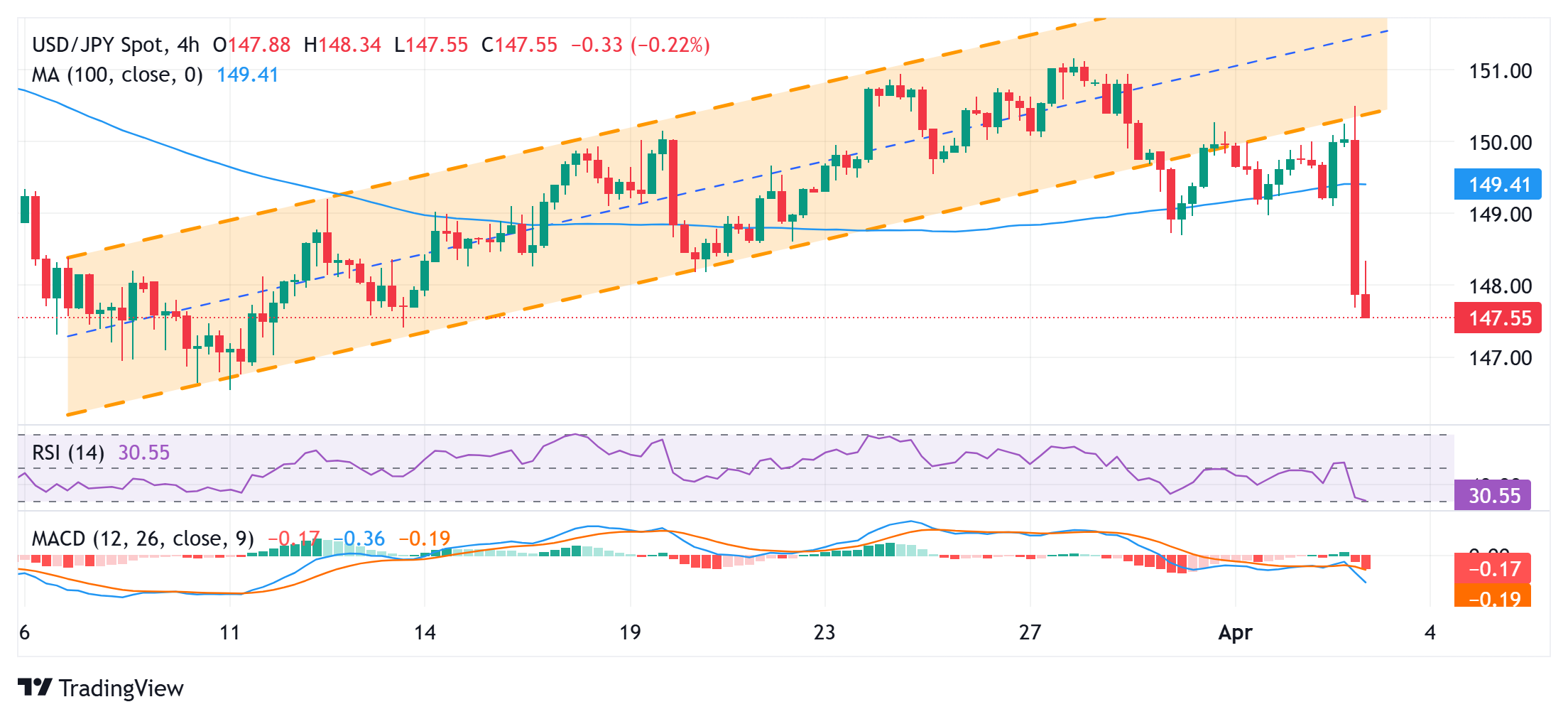Japanese Yen spikes to multi-week high against USD after Trump’s tariffs announcement
- The Japanese Yen rallies across the board amid Trump’s tariff-inspired global flight to safety.
- The narrowing of the US-Japan rate differential drives flows toward the lower-yielding JPY.
- The divergent BoJ-Fed expectations support prospects for a further USD/JPY depreciation.
The Japanese Yen (JPY) jumped to a three-week top against its American counterpart during the Asian session on Thursday after US President Donald Trump imposed sweeping trade tariffs. Investors grew increasingly concerned that the move could reshape the global trading system and dent global economic growth. This, in turn, triggers a fresh wave of the risk-aversion trade and boosts demand for traditional safe-haven assets, including the JPY.
Meanwhile, the anti-risk flow leads to a steep decline in the US Treasury bond yields, resulting in the further narrowing of the US-Japan rate differential and benefiting the lower-yielding JPY. The US Dollar (USD), on the other hand, dives back closer to a multi-month low touched in March amid worries about the impact of an escalating global trade on the US economy. This, along with a slew of weaker-than-expected US data, stoked recession fears.
The outlook might force the Federal Reserve (Fed) to resume its rate-cutting cycle soon. In contrast, traders have been pricing in the possibility of more interest rate hikes by the Bank of Japan (BoJ) amid signs of broadening domestic inflation. This, in turn, should contribute to the JPY's relative outperformance, which, along with the prevalent bearish sentiment surrounding the USD, suggests that the path of least resistance for the USD/JPY pair is to the downside.
Japanese Yen attracts safe-haven flows as Trump’s new tariffs fuel economic concerns and rattle global markets
- The global risk sentiment took a turn for the worst after US President Donald Trump unveiled reciprocal tariffs of at least 10% on all imported goods, sparking concerns over slowing global economic growth.
- Stock markets around the world plunged in reaction to the US tariffs announcement, lifting the safe-haven Japanese Yen to a three-week high against the US Dollar during the Asian session on Thursday.
- The anti-risk flow saw most global government bond yields fall, with the yield on the benchmark 10-year US government bond tumbling to the 4.0% neighborhood and hitting a fresh year-to-date low.
- Traders lifted bets that the Federal Reserve will start lowering borrowing costs at the June policy meeting and deliver a total of three 25-basis-point reductions to the policy rate by the end of this year.
- This, to a larger extent, overshadows Wednesday's upbeat US ADP report, which showed that private-sector employers added 155K jobs in March, far more than the 105K expected and 84K previous.
- Meanwhile, worries about the impact of harsher-than-expected US tariffs on Japan's economy forced investors to scale back their bets that the Bank of Japan would raise policy rate at a faster pace.
- However, the incoming macro data, including strong consumer inflation figures from Tokyo released last Friday, keeps the door open for further BoJ rate hikes, which, in turn, underpins the JPY.
- Traders now look forward to Thursday's US economic docket – featuring Weekly Initial Jobless Claims and the ISM Services PMI. The focus, however, will remain on trade-related developments.
USD/JPY seems vulnerable to weaken further; fresh breakdown below 100-period SMA on 4-hour chart in play

From a technical perspective, the intraday slump below the 100-period Simple Moving Average (SMA) on the 4-hour chart comes on top of the recent breakdown through a multi-week-old ascending channel. This, along with bearish oscillators on the daily chart, supports prospects for a further near-term depreciation for the USD/JPY pair. Hence, a subsequent fall towards the 147.25 intermediate support, en route to the 147.00 mark and the 146.55-146.50 region or a multi-month low touched in March, looks like a distinct possibility.
On the flip side, any attempted recovery might now confront some resistance near the 148.00 round figure. A sustained move, however, could trigger a short-covering rally towards the 148.65-148.70 region. That said, a further move up, is likely to attract fresh sellers near the 149.00 mark, which should cap the USD/JPY pair near the 149.35-149.40 region, or the 100-period SMA on the 4-hour chart. The latter should act as a key pivotal point, which if cleared decisively might negate the negative outlook and pave the way for additional near-term gains.
Tariffs FAQs
Tariffs are customs duties levied on certain merchandise imports or a category of products. Tariffs are designed to help local producers and manufacturers be more competitive in the market by providing a price advantage over similar goods that can be imported. Tariffs are widely used as tools of protectionism, along with trade barriers and import quotas.
Although tariffs and taxes both generate government revenue to fund public goods and services, they have several distinctions. Tariffs are prepaid at the port of entry, while taxes are paid at the time of purchase. Taxes are imposed on individual taxpayers and businesses, while tariffs are paid by importers.
There are two schools of thought among economists regarding the usage of tariffs. While some argue that tariffs are necessary to protect domestic industries and address trade imbalances, others see them as a harmful tool that could potentially drive prices higher over the long term and lead to a damaging trade war by encouraging tit-for-tat tariffs.
During the run-up to the presidential election in November 2024, Donald Trump made it clear that he intends to use tariffs to support the US economy and American producers. In 2024, Mexico, China and Canada accounted for 42% of total US imports. In this period, Mexico stood out as the top exporter with $466.6 billion, according to the US Census Bureau. Hence, Trump wants to focus on these three nations when imposing tariffs. He also plans to use the revenue generated through tariffs to lower personal income taxes.

